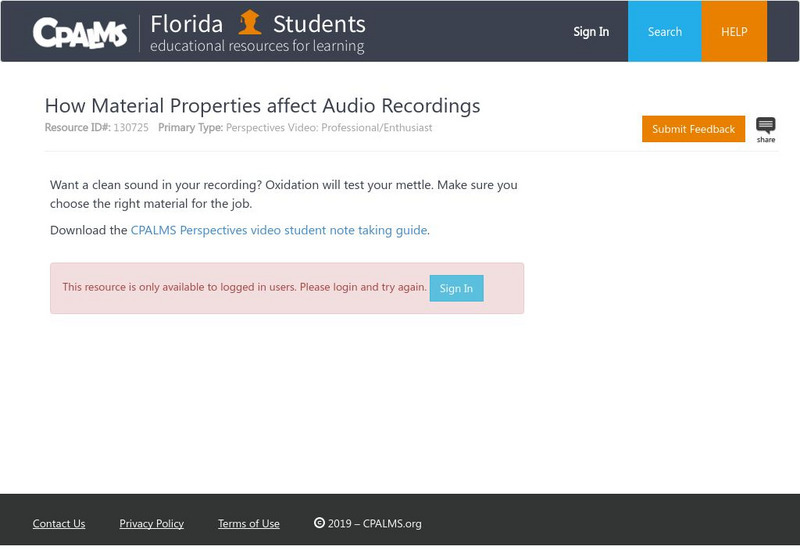Hi, what do you want to do?
Curated Video
Elements vs Alloys
We compare melting points of lead and tin to the melting point of their alloy, solder. By timing how long it takes samples of each to melt, we discover that the melting point of solder is actually lower than those of both lead and tin....
Institute of Art and Ideas
Are eternal laws an illusion?
From Newton's laws to E=mc2, we think we have uncovered the secrets of the universe. But some claim these laws evolve and others point to their human and cultural origins. Might eternal natural laws be human hubris? Or is the mind of God...
Institute of Art and Ideas
Do the laws of nature exist?
From Newton's laws to E=mc2, we think we have uncovered the secrets of the universe. But some claim these laws evolve and others point to their human and cultural origins. Might eternal natural laws be human hubris? Or is the mind of God...
FuseSchool
What Are Giant Chemical Structures
Learn the basics about the differences between different chemical structures, including giant covalent, giant ionic and metallic structures. There are numerous materials and substances that possess giant chemical structures. Some are...
Curated Video
Properties of Covalent Molecules and Giant Covalent Structures
The video is about covalent molecules, their properties and behavior. The video then goes on to discuss polymers, which are formed by the reaction of monomers with a C-C double bond. The video also discusses giant covalent structures,...
Curated Video
Extraction of Metals: Finding, Heating with Carbon, and Electrolysis
This video is about the extraction of metals. The presenter discusses how metals are found in nature, with most metals being found in compounds with other elements. He explains different methods for extracting metals from their...
FuseSchool
Group 1 - The Alkali Metals | The Periodic Table
A great summary about Group 1 in the Periodic table - The Alkali Metals.
Curated Video
Understanding the Chemical Properties of Elements in the Periodic Table
This video explains how the position of an element in the periodic table can help predict its chemical properties. The video starts with an overview of the periodic table and its organization, highlighting the separation of metals and...
Visual Learning Systems
Forming Bonds: Investigating Metallic Bonds
Upon viewing the Forming Bonds video series, students will be able to do the following: Understand that matter is made up of tiny particles called atoms. Explain that atoms consist of many different types of subatomic particles including...
Be Smart
How Do Glaciers Move?
A glacier is like a river of ice. An interesting lesson explores how solid glaciers manage to flow. The video instructor explains how the pressure of the weight of the ice decreases the melting point, allowing the glacier to move.
Teacher's Pet
Phase Diagrams
This is one phase you'll enjoy going through with your class! Young chemists discover the components of phase diagrams in a video lesson. The narrator discusses temperature and pressure, then shows how their interaction affects the state...
Veritasium
Why Is Ice Slippery?
Explore the science behind slippery ice. Ice is most slippery when it begins to melt, but even when temperatures are below freezing, ice becomes slippery when you walk on it. The video lesson explains how adding pressure to a solid...
Veritasium
Does Pressure Melt Ice?
Explore regelation of ice through a video demonstration. Applying pressure to a block of ice with a wire lowers the melting point and causes the ice to melt. As soon as the wire passes through, the water returns to its solid state as ice...
Fuse School
Recycling Glass
Investigate the recycling process of glass products. Young scholars learn the types of glass that are recyclable and make a connection to environmental chemistry. The video instructor explains the process of recycling the glass and its...
Fuse School
Giant Ionic Structures/Lattices
Ionic compounds don't exist as individuals; they only exist as a small part of an ionic lattice. The fourth video in a series of six discusses how the lattices form. It explains the attraction of ions and the common properties of these...
Fuse School
Giant Chemical Structures - Part 1
Get them thinking big about chemistry! Young chemists learn about the large and elaborate structures created through covalent bonding in the fourth of a six-part video series regarding elements, mixtures, and compounds. The video covers...
Crash Course Kids
Wood, Water, and Properties
Why do bricks make terrible windows? Learn about how the different properties of matter, including transparency, reflectivity, and freezing, boiling, and melting points can help you observe what they are, as well as indicate their...
Educreations
Types of Solids
Young chemists discover that all solids are not created equal with the help of this short instructional video. Taking a microscopic look at matter, students learn how to classify solids based on the type of bonds that are responsible for...
CPALMS
Florida State University Cpalms: Florida Students: How Material Properties Affect Audio Recordings
Learn how various physical properties of matter may affect processes with which the matter interacts.















